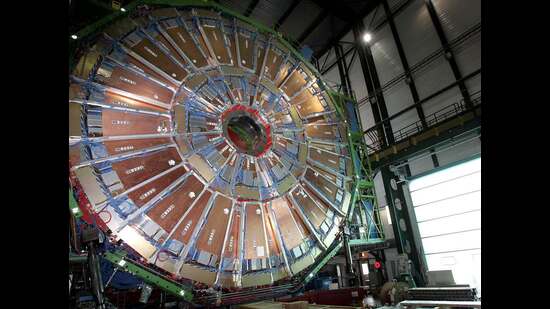India’s journey at CERN has been remarkable
Indian scientists have been an integral part of the science, engineering and computing aspects at CERN for more than half a century
Now is the era of globalisation and multidimensional collaboration in research. Not just an informal collaboration among a few scientists in a given discipline but partnerships across scientific institutions and universities in a given country, between countries as well as scientists across different disciplines of both science and engineering. This trend is prominent in a variety of mega projects operational across the world, driven sometimes by the need for global collaboration at a monetary and technological level for making things such as fusion energy a reality (for example, the International Thermonuclear Experimental Reactor, being funded by seven countries including India, to understand and replicate the fusion processes that generate energy in the sun) and at other times by the need of humankind to answer fundamental questions about the mysteries of nature and the universe, in say, particle physics, astrophysics or cosmology.

India has been involved or is preparing to engage in many of these “Mega Science” projects such as the Large Hadron Collider (LHC, which confirmed the existence of the Higgs Boson, one of the elementary particles) at CERN, the Laser Interferometer Gravitational-Wave Observatory (LIGO, for observing cosmic gravitational waves, which can help astronomers detect things like black holes), the Square Kilometre Array (SKA, which is building the world’s largest radio telescope) and the home based Indian Neutrino Observatory (INO).
Of these, the efforts at CERN — the European Laboratory for Nuclear Research that was founded some 70-odd years ago on the basis of international collaborations — have been the cradle of enormous leaps in particle physics or high energy physics.
Indian scientists have been an integral part of the science, engineering and computing aspects at CERN for more than half a century.
This association started with an informal collaboration in the 1960s. In 1992, the Department of Atomic Energy (DAE) signed a formal agreement with CERN, and the Department of Science and Technology (DST) also joined CERN activities in the 90s and supported universities. In 2002, India was awarded observer status, earning the right to sit at the global high table of research on the back of critical scientific and technological contributions of Indian scientists. In 2017, India became an associate member. Dedicated Indian groups are helping develop high-tech particle detectors, including high-end electronics for nuclear and particle physics experiments as well as medical imaging and other applications. Currently, discussions are on for renewing India’s associate member status and we hope this formal association gets strengthened.
India’s participation at CERN reflects a bottom-up approach, which first began through the collaboration of individual scientists. Today, it has blossomed. Scientists from India are involved in the global search for the fundamental particles that make up the world around us and the dark matter in the universe. This includes CMS-India (the Compact Muon Solenoid aimed at studying fundamental particles including the Higgs boson, and entities that could make up dark matter) and ALICE-India (which helps understand how the fundamental particles behaved just moments after the Big Bang) each being a group of about 120 scientists and engineers, working across many Indian institutes and universities. CMS (India) has participants from 14 institutions and at least 100 students have received their PhDs working on the experiment.
Indian groups have contributed significantly to the development of core software (such as Geant3, a simulation software that mimics the passage of elementary particles through matter) and major physics analyses such as the precision determination of W/Z boson mass and their widths — which were critical to confirm predictions about fundamental particles made by the standard model of physics — at the Large Electron-Positron Collider (LEP).
They continue to do so for LHC experiments across a wide spectrum of topics ranging from Higgs physics to signals for the formation of the Quark Gluon Plasma. This is critical to recreate the soup of elementary particles called quarks and gluons — which made up the universe for a few microseconds after the Big Bang, only to cool rapidly and form protons and neutrons. Indian theorists have contributed through important theoretical suggestions for physics beyond the standard model, novel strategies for the ongoing search for new physics, precision theory predictions for Higgs searches and helping establish the formation of the Quark Gluon Plasma in heavy ion collisions.
India has contributed to the designing, developing and deploying software for the Worldwide Large Computing Grid (WLCG), the world’s largest computing grid spread across 40-odd countries. CERN’s association has also been of use in Indian mega-projects like INO, which aims to study the neutrino, an elementary particle of nature that is notoriously hard to detect, and one that will involve building the world’s largest magnet.
India’s participation at CERN is the blueprint for all upcoming mega projects in the country. Indian particle, nuclear and accelerator physics communities cherish this long-term fruitful involvement and look forward to continuing this successful collaboration to probe into the secrets of nature, while simultaneously increasing the access of the Indian scientific and industrial community to the latest global technologies in the decades to come.
I must mention how much the Indian community is looking forward to the realisation of our home-grown project, INO, where Indian scientists have worked tirelessly for decades. A mini version of the detector is even taking data in a laboratory in Madurai. On this National Science Day, I would like to appeal to the political authorities and public at large to help make sure that this project, which puts India at the cutting edge in neutrino research, is not delayed any further than it already has been for various reasons.
Rohini Godbole is a theoretical particle physicist and an honorary professor at the Indian Institute of Science The views expressed are personal
All Access.
One Subscription.
Get 360° coverage—from daily headlines
to 100 year archives.



HT App & Website







